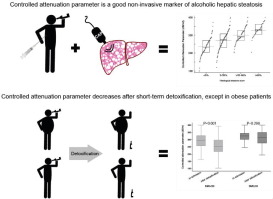当前位置:
X-MOL 学术
›
J. Hepatol.
›
论文详情
Our official English website, www.x-mol.net, welcomes your
feedback! (Note: you will need to create a separate account there.)
Controlled Attenuation Parameter And Alcoholic Hepatic Steatosis: Diagnostic Accuracy and Role Of Alcohol Detoxification
Journal of Hepatology ( IF 26.8 ) Pub Date : 2018-05-01 , DOI: 10.1016/j.jhep.2017.12.029 Maja Thiele , Vanessa Rausch , Gabriele Fluhr , Maria Kjærgaard , Felix Piecha , Johannes Mueller , Beate Katharina Straub , Monica Lupșor-Platon , Victor De-Ledinghen , Helmut Karl Seitz , Sönke Detlefsen , Bjørn Madsen , Aleksander Krag , Sebastian Mueller
Journal of Hepatology ( IF 26.8 ) Pub Date : 2018-05-01 , DOI: 10.1016/j.jhep.2017.12.029 Maja Thiele , Vanessa Rausch , Gabriele Fluhr , Maria Kjærgaard , Felix Piecha , Johannes Mueller , Beate Katharina Straub , Monica Lupșor-Platon , Victor De-Ledinghen , Helmut Karl Seitz , Sönke Detlefsen , Bjørn Madsen , Aleksander Krag , Sebastian Mueller

|
BACKGROUND & AIMS
Controlled attenuation parameter (CAP) is a novel non-invasive measure of hepatic steatosis, but it has not been evaluated in alcoholic liver disease. Therefore, we aimed to validate CAP for the assessment of biopsy-verified alcoholic steatosis and to study the effect of alcohol detoxification on CAP. METHODS
This was a cross-sectional biopsy-controlled diagnostic study in four European liver centres. Consecutive alcohol-overusing patients underwent concomitant CAP, regular ultrasound, and liver biopsy. In addition, we measured CAP before and after admission for detoxification in a separate single-centre cohort. RESULTS
A total of 562 patients were included in the study: 269 patients in the diagnostic cohort with steatosis scores S0, S1, S2, and S3 = 77 (28%), 94 (35%), 64 (24%), and 34 (13%), respectively. CAP diagnosed any steatosis and moderate steatosis with fair accuracy (area under the receiver operating characteristic curve [AUC] ≥S1 = 0.77; 0.71-0.83 and AUC ≥S2 = 0.78; 0.72-0.83), and severe steatosis with good accuracy (AUC S3 = 0.82; 0.75-0.88). CAP was superior to bright liver echo pattern by regular ultrasound. CAP above 290 dB/m ruled in any steatosis with 88% specificity and 92% positive predictive value, while CAP below 220 dB/m ruled out steatosis with 90% sensitivity, but 62% negative predictive value. In the 293 patients who were admitted 6.3 days (interquartile range 4-6) for detoxification, CAP decreased by 32 ± 47 dB/m (p <0.001). Body mass index predicted higher CAP in both cohorts, irrespective of drinking pattern. Obese patients with body mass index ≥30 kg/m2 had a significantly higher CAP, which did not decrease significantly during detoxification. CONCLUSIONS
CAP has a good diagnostic accuracy for diagnosing severe alcoholic liver steatosis and can be used to rule in any steatosis. In non-obese but not in obese, patients, CAP rapidly declines after alcohol withdrawal. LAY SUMMARY
CAP is a new ultrasound-based technique for measuring fat content in the liver, but has never been tested for fatty liver caused by alcohol. Herein, we examined 562 patients in a multicentre setting. We show that CAP highly correlates with liver fat, and patients with a CAP value above 290 dB/m were highly likely to have more than 5% fat in their livers, determined by liver biopsy. CAP was also better than regular ultrasound for determining the severity of alcoholic fatty-liver disease. Finally, we show that three in four (non-obese) patients rapidly decrease in CAP after short-term alcohol withdrawal. In contrast, obese alcohol-overusing patients were more likely to have higher CAP values than lean patients, irrespective of drinking.
中文翻译:

受控衰减参数和酒精性肝脂肪变性:酒精解毒的诊断准确性和作用
背景和目的 受控衰减参数 (CAP) 是一种新型的非侵入性肝脂肪变性测量方法,但尚未在酒精性肝病中进行评估。因此,我们旨在验证 CAP 用于评估活检证实的酒精性脂肪变性,并研究酒精解毒对 CAP 的影响。方法 这是一项在四个欧洲肝脏中心进行的横断面活检控制的诊断研究。连续酗酒的患者接受了伴随的 CAP、定期超声和肝活检。此外,我们在一个单独的单中心队列中测量了入院前和入院后的 CAP。结果 研究共纳入 562 名患者:诊断队列中 269 名患者的脂肪变性评分为 S0、S1、S2 和 S3 = 77 (28%)、94 (35%)、64 (24%) 和 34 (13%),分别。CAP 诊断任何脂肪变性和中度脂肪变性具有相当的准确性(受试者工作特征曲线下面积 [AUC] ≥S1 = 0.77;0.71-0.83 和 AUC ≥S2 = 0.78;0.72-0.83),以及具有良好准确性的严重脂肪变性 (AUC S3) = 0.82;0.75-0.88)。CAP 优于常规超声的明亮肝脏回声模式。CAP 高于 290 dB/m 以 88% 的特异性和 92% 的阳性预测值排除脂肪变性,而低于 220 dB/m 的 CAP 以 90% 的敏感性排除脂肪变性,但阴性预测值为 62%。在 6.3 天(四分位距 4-6)接受解毒治疗的 293 名患者中,CAP 降低了 32 ± 47 dB/m (p <0.001)。无论饮酒模式如何,体重指数都预测了两个队列中较高的 CAP。体重指数≥30 kg/m2 的肥胖患者的 CAP 显着升高,在解毒过程中没有明显减少。结论 CAP诊断重度酒精性肝脂肪变性具有良好的诊断准确性,可用于任何脂肪变性的诊断。在非肥胖但非肥胖患者中,酒精戒断后 CAP 迅速下降。LAY 总结 CAP 是一种新的基于超声的技术,用于测量肝脏中的脂肪含量,但从未针对酒精引起的脂肪肝进行过测试。在此,我们在多中心环境中检查了 562 名患者。我们表明 CAP 与肝脏脂肪高度相关,通过肝活检确定,CAP 值高于 290 dB/m 的患者很可能肝脏中脂肪含量超过 5%。在确定酒精性脂肪肝疾病的严重程度方面,CAP 也优于常规超声检查。最后,我们表明,四分之三(非肥胖)患者在短期戒酒后 CAP 迅速下降。相比之下,无论是否饮酒,肥胖过度饮酒的患者都比瘦弱的患者更有可能具有更高的 CAP 值。
更新日期:2018-05-01
中文翻译:

受控衰减参数和酒精性肝脂肪变性:酒精解毒的诊断准确性和作用
背景和目的 受控衰减参数 (CAP) 是一种新型的非侵入性肝脂肪变性测量方法,但尚未在酒精性肝病中进行评估。因此,我们旨在验证 CAP 用于评估活检证实的酒精性脂肪变性,并研究酒精解毒对 CAP 的影响。方法 这是一项在四个欧洲肝脏中心进行的横断面活检控制的诊断研究。连续酗酒的患者接受了伴随的 CAP、定期超声和肝活检。此外,我们在一个单独的单中心队列中测量了入院前和入院后的 CAP。结果 研究共纳入 562 名患者:诊断队列中 269 名患者的脂肪变性评分为 S0、S1、S2 和 S3 = 77 (28%)、94 (35%)、64 (24%) 和 34 (13%),分别。CAP 诊断任何脂肪变性和中度脂肪变性具有相当的准确性(受试者工作特征曲线下面积 [AUC] ≥S1 = 0.77;0.71-0.83 和 AUC ≥S2 = 0.78;0.72-0.83),以及具有良好准确性的严重脂肪变性 (AUC S3) = 0.82;0.75-0.88)。CAP 优于常规超声的明亮肝脏回声模式。CAP 高于 290 dB/m 以 88% 的特异性和 92% 的阳性预测值排除脂肪变性,而低于 220 dB/m 的 CAP 以 90% 的敏感性排除脂肪变性,但阴性预测值为 62%。在 6.3 天(四分位距 4-6)接受解毒治疗的 293 名患者中,CAP 降低了 32 ± 47 dB/m (p <0.001)。无论饮酒模式如何,体重指数都预测了两个队列中较高的 CAP。体重指数≥30 kg/m2 的肥胖患者的 CAP 显着升高,在解毒过程中没有明显减少。结论 CAP诊断重度酒精性肝脂肪变性具有良好的诊断准确性,可用于任何脂肪变性的诊断。在非肥胖但非肥胖患者中,酒精戒断后 CAP 迅速下降。LAY 总结 CAP 是一种新的基于超声的技术,用于测量肝脏中的脂肪含量,但从未针对酒精引起的脂肪肝进行过测试。在此,我们在多中心环境中检查了 562 名患者。我们表明 CAP 与肝脏脂肪高度相关,通过肝活检确定,CAP 值高于 290 dB/m 的患者很可能肝脏中脂肪含量超过 5%。在确定酒精性脂肪肝疾病的严重程度方面,CAP 也优于常规超声检查。最后,我们表明,四分之三(非肥胖)患者在短期戒酒后 CAP 迅速下降。相比之下,无论是否饮酒,肥胖过度饮酒的患者都比瘦弱的患者更有可能具有更高的 CAP 值。











































 京公网安备 11010802027423号
京公网安备 11010802027423号